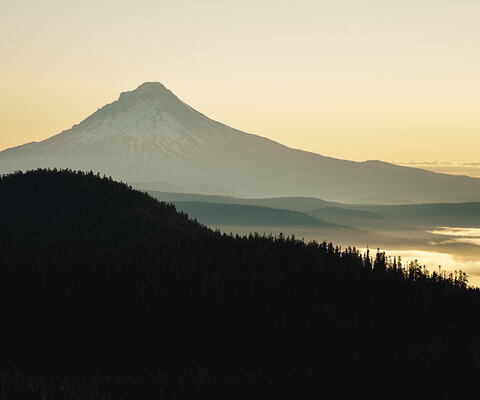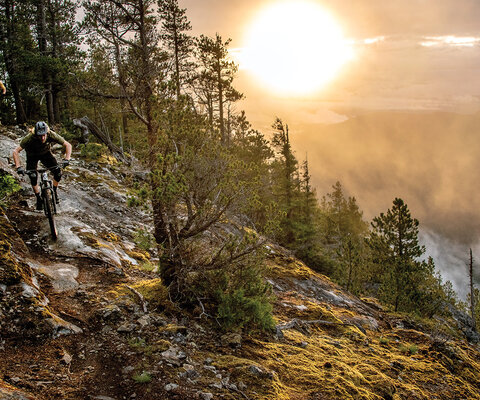
Call of the Bedouin Straying from the Herd in Jordan’s Highlands
Words by Andrew Findlay | Photos by Kari Medig
I hear voices. Or perhaps it’s the wind singing through the dry canyon. We push and pedal the last hundred vertical feet toward a notch in a spiny ridge. Goat prints and rock cairns mark the way. The view makes me giggle.
Old trails in old lands have that effect on me. A playground of rock rolls and sandstone slabs funnel into a strip of trail as white as gypsum that cuts across a bench of rare flat ground.
“Yalla! (Let’s go!)” our guide, Sari Husseini, calls out in Arabic, uttering the second most important expression among the dozen or so mountain bikers in Jordan.
The first is “Inshallah (God willing).” If you wish for something to happen, then go straight to the top and invoke God. Even a non-believer like me believes that prayers are sometimes answered with a gift—and this trip is a gift that keeps on giving.
We’re in southwestern Jordan, in the remote valley of Abu Qusaib, and though there are ancient trails here it seems unlikely that they’ve been ridden by bikes. Even the Bedouin shepherd we’d met earlier at the trailhead pointed to our bikes and said he’d never seen “those things” around here.
“Yalla, yalla!” I reply to Sari, clipping into my pedals and launching down the gritty sandstone. Seconds later, sharp white gravel crunches under my tires, giving a moment of respite before the trail curves onto an arm-length-wide ledge. On one side, a slot canyon disappears into darkness. On the other, tangerine-pink rock rises upward, sculpted by wind and water into a fa ade of gargoyles and ghouls.
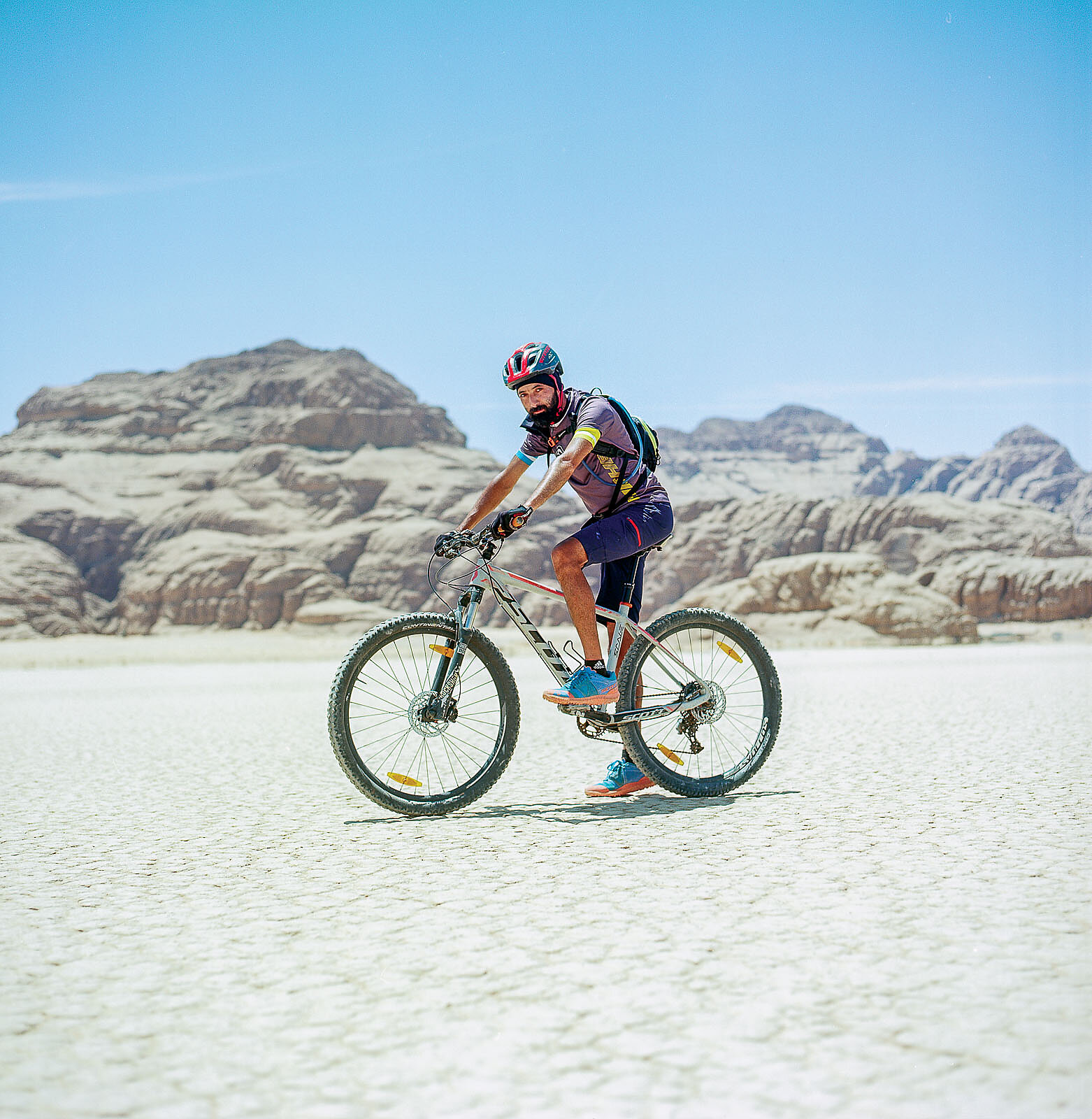
All of my muscles are engaged, especially my brain. I focus on front-wheel management. Babyhead rocks litter the trail. So does goat dung. Istay in third gear to torque up a knee-high step, holding my breath as I wrap around the exposed ledge and back onto less consequential terrain. I exhale. My mind mulls over my best days ever on a bike; there’s been quite a few. This one already ranks, and it’s not even half over. The trail beckons us onward up the wadi, the Arabic word for valleys that flash flood when it rains. Besides what remains in our bottles, there’s not a drop in sight.
Again, I hear voices. I wonder if the unrelenting desert sun is taking its toll. Soon we’re granny-gearing upward. Loose rock makes for delicate pedaling. When I crest the rise, I’m startled by a young Bedouin goatherder crouched on the hillside, chatting to an older woman who is shrouded from head to toe in black.
Equally surprised, they spring to their feet and scramble a few yards away, not sure what to makeof these sun-scorched interlopers on bikes. Their dog yaps nervously. Then the young one steps forward. The whites of her lively eyes, bright against deep-brown skin, flash through the opening in her hijab.
“Where are you from?” she calls out in highpitched Arabic.
“Canada,” Sari tells her, nodding at me and photographer Kari Medig.
“Canada!” she shouts, incredulous, before uttering something else in Arabic.
I ask Sari to translate. He hesitates, then sheepishly shrugs.
“She said, ‘Why don’t you go back to your own place?’”

He assures us it’s not meant as it sounds. It’s more an expression of surprise over why we would travel across oceans and continents to ride bikes in the canyons of Jordan, a place inhabited for generations upon generations by her Bedouin kin. For us, the answer is obvious: It’s written plainly upon the ancient trails crisscrossing the otherworldly landscape around us.
Last fall, I learned of the Jordan Trail, a 420-mile-long hiking route that traverses the country from north to south. I was intrigued and began a few months of back and forth with contacts in Jordan. It quickly became clear that the country’s entire mountain bike community could fit in someone’s living room. The concept of riding bikes on narrow singletrack was understood by few. Even for Sari, who is mostly accustomed to leading bike tours on dirt roads, the idea of taking bikes onto actual trails was somewhat novel. We were lucky he was such a good sport.
Except for 16 miles of Red Sea shoreline, Jordan is landlocked by Israel, Palestine, Syria, Iraq and Saudi Arabia. It’s an island of stability in a region fraught with conflict. For thousands of years, its strategic location in the heart of the Arab world put it at the crossroads of trade and conquest. The overlapping influences of the Nabateans—ancient Arab nomads who carved the magical city of Petra out of sandstone cliffs—Islamic kings, Roman conquerors, Crusaders and Ottoman rulers are layered upon the land like a messy, home-baked birthday cake.
Past experiences informed me that any country with thousands of years of civilization must have age-old human highways that could be explored on bikes. And parts of the Jordan Trail would surely be good places to start. We were fortunate to find an amenable soul in Sari, a 35-year-old Jordanian of Palestinian heritage who was born in Jerusalem and now owns a bike store in the Jordanian capital of Amman. From our first meeting, I liked Sari. He was funny and generous in spirit, with a self-professed weakness for McDonald’s fast food. He was both whip smart and as candid as a child without the filter of experience.

Sari had commandeered his friend, Ahmad Al-Saheb, to be our driver for the trip, willingly shuttling us around the country in search of spectacular singletrack. And it wasn’t long into this adventure that we felt like we’d adopted two Arab brothers. In the ultimate form of male road trip bonding, we swapped off-color expressions in our native languages, but we also learned about the hopes and struggles of two 30 something Jordanian men trying to balance the expectations of conservative Muslim society with Western notions of personal liberty.
Some folks ruminate quietly with thoughts like these, but not Sari. He can talk circles around an auctioneer while simultaneously chatting through a Bluetooth device that’s permanently attached to his right ear. Normally I would find this obnoxious, but Sari’s chatter is endearing and always interesting.
But now that we’re pushing our bikes through soft sand, drudgery at the end of a long day in the saddle, even the gregarious Sari is quiet. We plod through a shifting, golden landscape, the only way out of the Abu Qusaib valley. A camel would make more sense here.
Our trip has inconveniently coincided with the tail end of Ramadan, the most important occasion on the Muslim calendar, marked by 30 days of fasting from sunup to sundown. Sari tells me he opted out of fasting for the last two days of Ramadan.
“We won’t tell anyone,” I say, pausing to empty the last drops of water from my bottle.
“The only one who matters already knows,” Sari replies with a wink before explaining a few practical Muslim workarounds. “If you skip a day of fasting you can do a make-up day to compensate.”
My mind wanders from the challenges of fasting during a mountain bike adventure to the description I read last night of the yellow scorpion, endemic to Jordan: “Extraordinarily painful sting. Can be lethal or cause pancreatitis.”
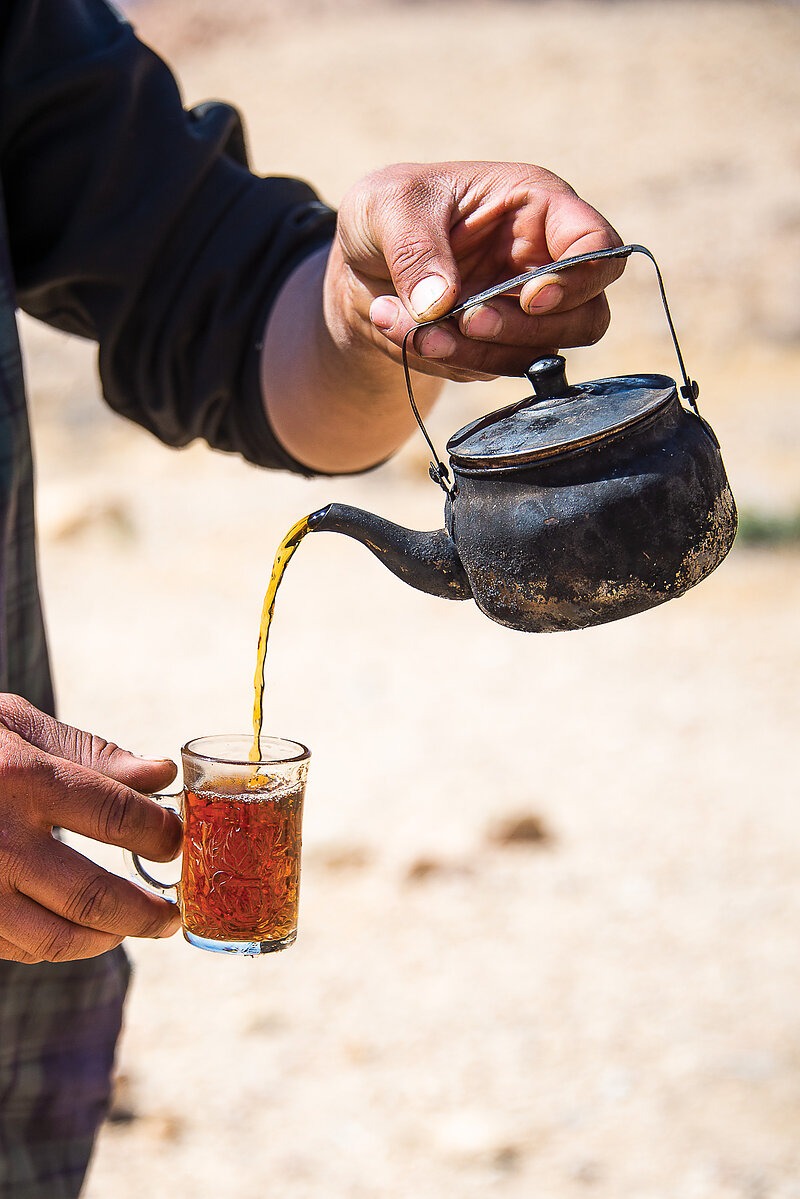
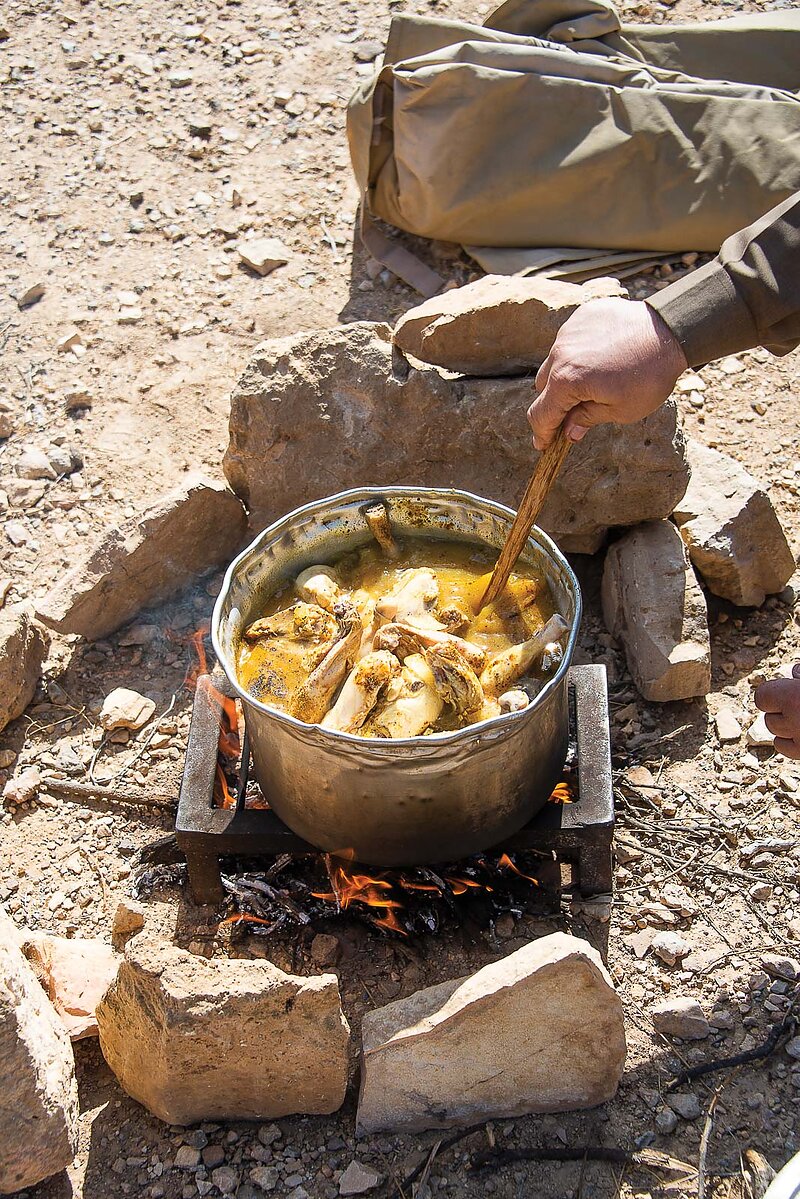

Afternoon fades to evening. My mouth feels pasty. Where the wadi spills out into an open plain we find flat, hardpacked dirt. Three barefooted boys sprint toward us from a cluster of tents. Sari knows them from a previous hiking trip in the area.
“These people will look after you if you get in trouble,” Sari says, revealing his Bedouin search-and-rescue contingency if something goes sideways on the trail.
We’re ushered into a tent for tea with two men, brothers-in-law and the patriarchs of this extended family. In the deserts of Jordan, Bedouin generosity is extended without expectation of return, as natural of a human impulse as breathing. The men roll out a tattered red blanket and pillows for us to sit on. The tea is served sweet, as it always is in Jordan. It’s normally too sweet for my taste, but right now it’s perfect.
Naturally, the men ask where we’re from.
“Canada,” Sari says again.
The two men nod, but their curiosity ends there. They continue chatting in Arabic and filling our teacups. Eventually, Sari places his right hand over his heart, as is customary, and thanks our hosts. We still have four miles to ride to our meeting point with Ahmad on the highway that cuts arrow-straight through the Ard as Sawwān desert plain. The Bedouins offer us a ride in their pickup, but we decline, feeling refreshed and energized by the welcome cool of the evening.
The next day Medig and I bounce around in the back seat of our truck as Ahmad navigates a rough road near Ras al-Feid, a bony headland high above a barren riverbed. Water dominates political discourse in Jordan for good reason: There’s not much of it. The chatter up front is intense, almost heated. Sari studies maps on his phone while formulating an emergency plan with Ahmad. His Bluetooth earpiece, as always, is attached to his right ear, even though we lost the signal an hour before.

“It sounds like we’re arguing, but we’re not,” Sari says, looking in the rearview mirror. “That’s just how we talk in Arabic.”
From across the valley, we spot our trail—a series of switchbacks etched on a mountain named Jabal as Saffāhah. An enticing goat path contours the hillside just below the road.
“Why don’t we start riding here?” I suggest.
“Sure, why not?,” Sari replies.
We load packs with food, fill water bottles and leave Ahmad, who has taken to worrying about us like a doting uncle, even though he’s young enough to be my son. The trail is raw and rugged, traveled most often by animals but also animated by human history, from the ancient footfalls of Roman soldiers and tribal Arab kings to modern-day hikers.
It’s a brake-pad burner to the valley floor. Loose rocks make cornering treacherous. Sari does well at handling his hardtail cross-country bike, complete with a seat-mounted reflector. Despite his initial trepidation, our guide has proven adept at balancing self-preservation with a willingness to push his riding skills.
We shoulder our bikes across the dry riverbed and begin ascending the mountain. Stunted conifers, branches sinewy and gnarled like the sunburned arms of an old man, grow stubbornly from cracks in the rock. I joke with Sari about my weeklong hiatus from post-ride beers, making him promise a visit to Carakale Brewing Company, the country’s only craft brewery, located near Amman, before we fly home.
Forty-five minutes of pedaling and pushing gets us to the ridge. We follow the trail along the crest, climbing for another 20 minutes to Saffāhah’s summit. To the west, valleys form deep folds between vertical sandstone pillars. Goat trails spindle off temptingly in all directions. It’s a wild and sparsely populated landscape compared to the country’s north, where we started this road trip.

We linger at this inspiring viewpoint overlooking Jordan’s mountainous south. There’s not a soul in sight, and the silence is broken only by the chatter of Sari giving Ahmad a progress report over a two-way radio. As he looks at the thin line of singletrack unraveling before us, I notice a feverish twinkle in his eyes.
“My God!” he exclaims.
Wary of passing time and the unknowns ahead, we hop back on our bikes and tear into the smooth, ripping-fast dirt. Off-camber rock slabs and assertive climbs weave through house-sized boulders—trail perfection manifested on a mountainside of our own. The only thing more beautiful than the trail is the landscape around us. But the riding demands focus. After rounding a ridge, we see a cluster of pickups blocking the trail ahead.
“Salam,” I say as we roll up.
“Salam,” replies a tall guy with a pair of gold incisors that shine when he speaks.
He’s among a group of friends out celebrating Eid-ul-Fitr, the post-Ramadan holiday. As if by magic, one of them coaxes flames from a handful of twigs, arranges rocks around them and puts a kettle on for tea. This leads to a lunch invitation from a round man with an easy laugh and a self-assured authority. Sari tells us that he’s an imam, or Muslim priest. My restless North American impulse is to kindly decline the invitation, but it would be rude to just ride away.
Soon a dozen of us are sitting cross-legged in a circle, with two Suzuki Samurais parked at angles to block the wind. The conversation is lively. The imam jokes about coming to Canada to look for a younger wife. A devout young man with intense eyes, a mustache-less beard and prayer beads in one hand has more practical concerns and wants to know what we Canadians get for our taxes. A chain-smoking guy in black pants and a black leather jacket makes fun of his truck-driving friend before abruptly asking us a question.
Though it feels like weeks ago, it’s only been days since we first hit Jordanian dirt at Umm Qais, a hilltop village next to the sprawling Roman ruins of Gadara. Or since we rode with the affluent members of an informal bike club on the country’s only purpose-built mountain bike trail, a scrappy affair in Amman National Park, a forested picnic area frequented mostly by the capital’s residents.


“What do you think about alcohol?” he asks through our tireless translator, Sari. “Is it good or bad?”
It’s a loaded question among people whose faith officially prohibits booze. If only they knew the true extent of my hedonist, heathen ways. I glance at the imam, who’s listening intently. His face lights up with laughter, and he gets up to fetch a platter of rice and chicken that has been cooking in a huge cauldron over an open flame.
“Everything in moderation, I suppose,” I cautiously answer.
Three hours after stumbling upon this crew, Sari looks at his watch. Sunset is less than an hour away. Impending darkness is a powerful motivator, especially when you don’t have lights.
“We must go. Ahmad will be getting worried,” Sari says, winking.
The three of us rise from the ground. Effusive thanks are neither expected nor required. Breaking bread and generosity with strangers is compulsory in a land where coping with scarcity is baked into the DNA of its inhabitants. I start pedaling, legs heavy with lactic acid, feeling like I’m on a different planet.
The evening light casts an ethereal glow on the sandstone cliffs that surround us. Rocks and drops make for techy riding where the trail dips through dry gulches, the only evidence of the rain that rarely visits this land. We move only slightly faster than walking pace. Where the terrain mellows, our pace quickens. Smooth dirt and rock slabs lead to a high point. I stop to drink from a Pepsi that the imam gave me as a parting gift, then I drink in the tantalizing view of another mesmerizing valley.
My arms and legs are bloodied and scratched. The trails of Jordan have left their mark on me, both physically and in some ways spiritually. We’d come on a self-absorbed quest to find singletrack, but along the way we’d discovered something much more important: The warmth, humor and kindness of the Jordanian people, and a basic humanity that bridges language and culture, no matter how wide the gulf may be.
We spot Ahmad’s truck parked near a huddle of Bedouin tents about a mile away. He’ll be pacing and looking at his watch.
“We are blessed,” Sari says.
